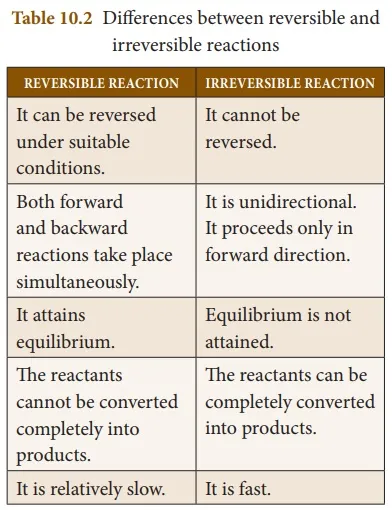
Classification based on the direction of the reaction
You know that innumerable changes occur every day around us. Are all they permanent? For example, liquid water freezes into ice, but then ice melts into liquid water. In other words, freezing is reversed. So, it is not a permanent change. Moreover, it is a physical change. Physical changes can be reversed easily. Can chemical changes be reversed? Can the products be converted into reactants? Let us consider the burning of a wood. The carbon compounds present in the wood are burnt into carbon dioxide gas and water. Can we get back the wood immediately from carbon dioxide and water? We cannot. So, it is a permanent change. In most of the cases, we cannot. But, some chemical reactions can be reversed. Our mobile phone gets energy from its lithium ion battery by chemical reactions. It is called discharging. On recharging the mobile, these chemical reactions are reversed. Thus, chemical reactions may be reversed under suitable conditions. Hence, they are grouped into two categories such as reversible and irreversible reactions.

Reversible Reactions
A reversible reaction is a reaction that can be reversed, i.e., the products can be converted back to the reactants. A reversible reaction is represented by a double arrow with their heads in the direction opposite to each other. Thus, a reversible reaction can be represented by the following equation:

Explanation: Here, the compound ‘AB’ undergoes decomposition to form the products ‘A’ and ‘B’. It is the forward reaction. As soon as the products are formed, they combine together to form ‘AB’. It is the backward reaction. So, the reaction takes place in both the directions. Do you think then that no products are formed in the aforesaid reaction? If you think so, you are wrong. Because, even though the reaction takes place in both the directions, at the initial stage the rates (speed) of these reactions are not equal. Consider the following decomposition reaction of phosphorous pentachloride into phosphorous trichloride and chlorine.

The forward reaction is the decomposition of PCl5 and the backward reaction is the combination of PCl3 and Cl2. Initially, the forward reaction proceeds faster than the backward reaction. After sometimes, the speed of both the reactions become equal. So, PCl5 cannot be completely converted into the products as the reaction is reversed. It is a reversible reaction. The actual measurements of the given reaction show that the reaction is at equilibrium, but the amount of PCl5 is more than that of PCl3 and Cl2.
Thus, more amount of products can be obtained in a reversible reaction by the periodical removal of one of the products or the periodical addition of the reactants.

Irreversible Reactions
The reaction that cannot be reversed is called irreversible reaction. The irreversible reactions are unidirectional, i.e., they take place only in the forward direction. Consider the combustion of coal into carbon dioxide and water.

In this reaction, solid coal burns with oxygen and gets converted into carbon dioxide gas and water. As the product is a gas, as soon as it is formed it escapes out of the reaction container. It is extremely hard to decompose a gas into a solid. Thus, the backward reaction is not possible in this case. So, it is an irreversible reaction. Table 10.2 provides the main differences between a reversible and an irreversible reaction:

You will learn more about these reactions in your higher classes.